The World of DOT and Diagnostic Inspections: A Deeper Dive

A wise man once said, “Performing DOTs should not be a courtesy item.”
We’ll repeat those words:
Performing DOTs should not be a courtesy item.
The wise man in question is Don Doty, VP of Roadside Operations & Vendor Relations at FleetNet America, and that quote was pulled directly from the 2022 edition of the State of Heavy-Duty Repair.
Honestly, we like the whole quote a lot, so let’s just include the rest of it here.
“It’s important [that] service providers get paid fairly for their [work] if they are going to invest in the people, tools, equipment, and technology to be at the top of their game,” he goes on. “I can’t stress how important it is, and will be, that shops [charge properly] to fuel their business.”
We firmly agree with Don in this regard. Commercial repair shops should definitely charge for diagnostic and DOT inspections; these two types of inspections are critical to maintaining uptime and safety, and they demand a tech’s time and careful attention. Customers absolutely should be paying for this important service either as a separate line item on an invoice—or at the very least have the inspection fee rolled into the repair service order.
Taking a cue from the automotive repair industry, a shop could have set rates for these services and then waive the fee if ths customer accepts the repairs found during the inspection. No matter what you choose, make sure your shop is whole in compensation after your technicians take their time to look over a customer’s vehicle.
But how many are paying what such inspections are worth? Are shops charging enough for them?
The State of Heavy-Duty Repair produced a lot of interesting data points, not all of which we included in the published report (hey, we had to stop somewhere or it’d weigh ten pounds!). Here’s what the report has to say about DOT and diagnostic inspections:
Just over half of the shops surveyed make DOT inspections free, or only charge up to $100. A very small percentage (16%) charge up to $500 for this inspection. All told, the average rate is $132.38.
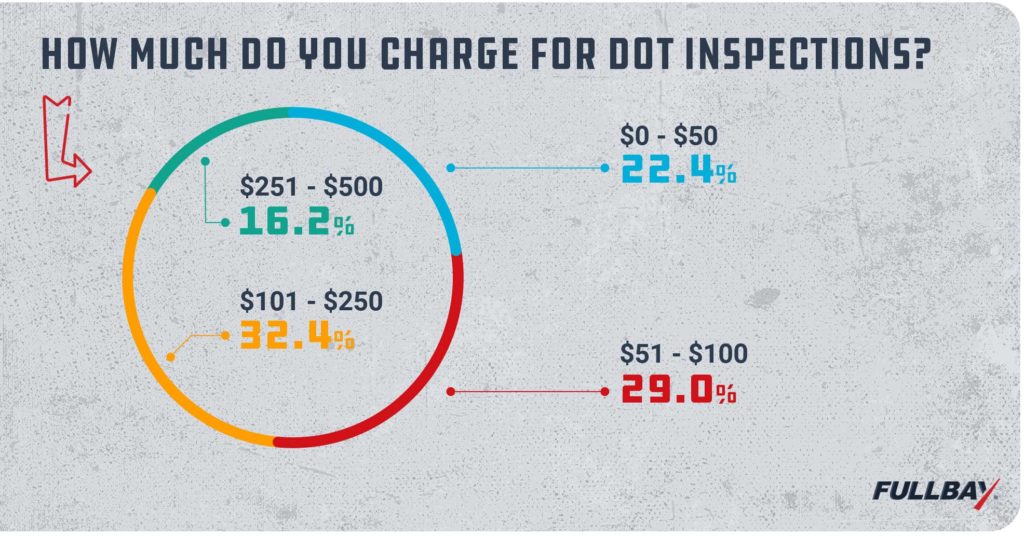
The numbers for diagnostic inspections are equally interesting. Over 78.3% of shops do charge for these inspections, with the average rate being $177. With that said, 21.7% of shops surveyed don’t charge for diagnostic inspections at all.
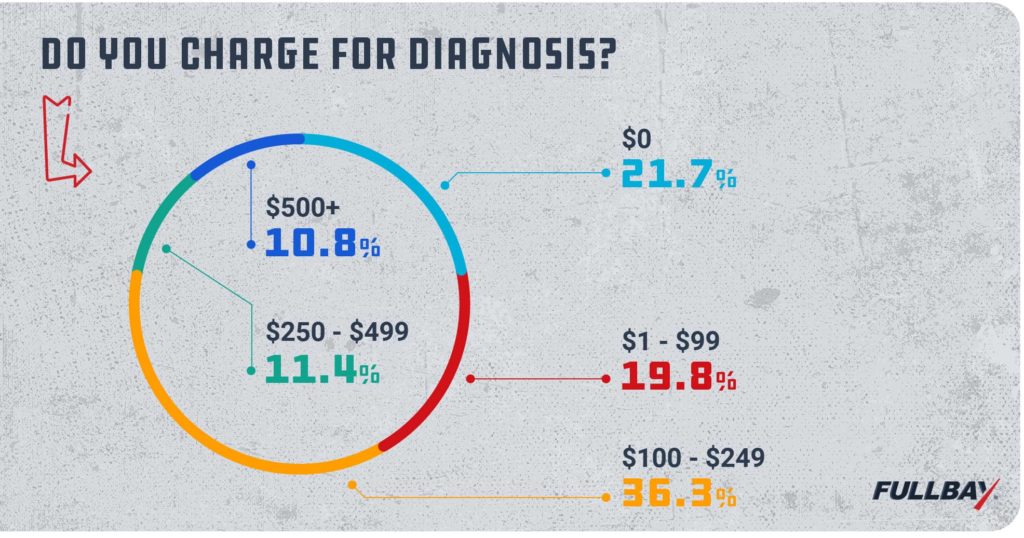
OK, the scene is set. Now let’s take a look at some additional data that we didn’t include in the report.
CHARGING FOR DIAGNOSTICS: WHO DOES IT MORE?
Before going any further, we should point out that this data is from U.S.-based commercial repair shops only (sorry, Canadian friends!). We also focused on independent repair shops, rather than internal fleets, unless otherwise noted.
Here’s some information that didn’t make it into the final report: by and large, the newer shops charged more for diagnostic and DOT inspections, while the older shops (those around 20+ years) charged comparatively little.
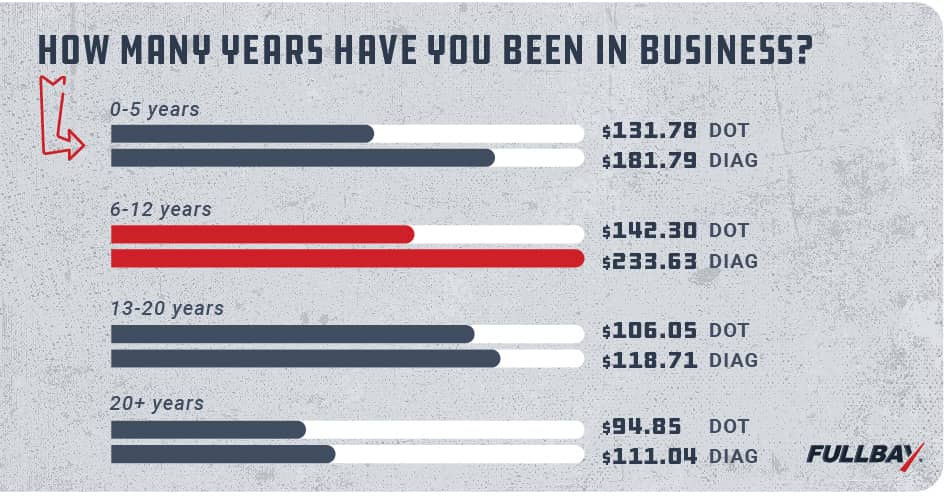
DO CHEAPER DIAGNOSTICS CORRELATE WITH LOWER WAGES?
Just for fun, we looked at where these shops were located. The Southwest led the pack in both DOT and diag pricing, averaging $153.53 and $238.79 for each, respectively. The West was right behind it, averaging $138.63 and $220.96. You can see the rest below:
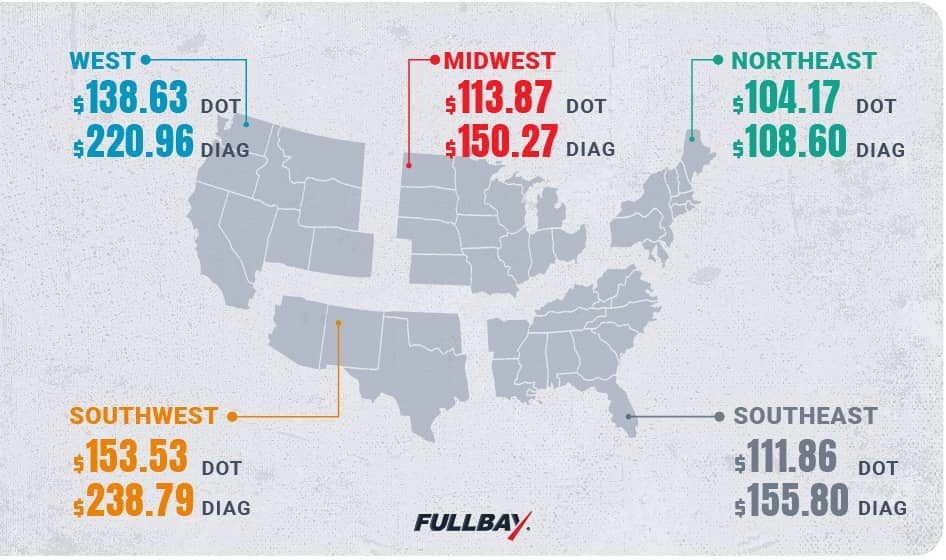
This was already pretty interesting, but we felt there must be more.
We kept looking at the data. We did some fancy computer stuff. We realized that the numbers revealed something else: shops that were not charging top rates for diagnostics and inspections
were also reporting they found it “much more difficult” to hire techs.
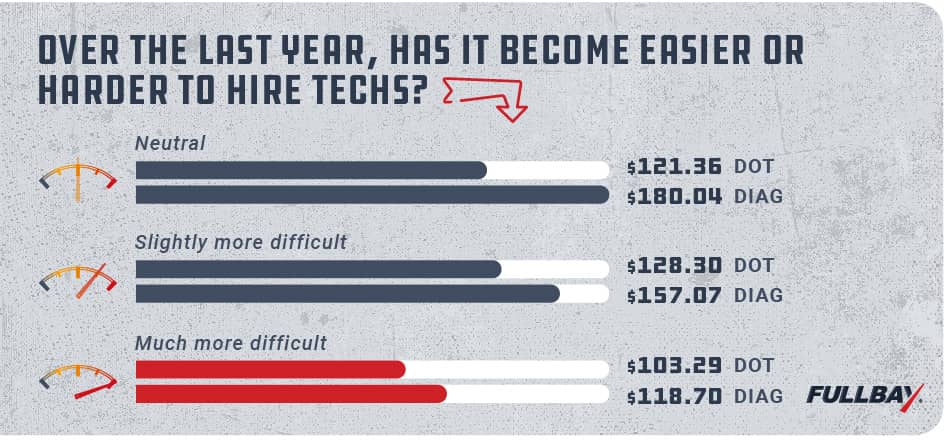
Is there a connection?
Maybe. We explored the numbers a little more and found that shops that did charge more for DOT and diag stated that hiring techs was only “slightly more difficult” than it had been in previous years.
This may imply—stress on the “may”—that the loss of income from these two critical types of inspections isn’t allowing shops to pay their technicians as much, or provide the kind of wages necessary to attract techs in the current hiring environment. Obviously this is just one theory, but the correlation surprised us enough to make us want to write about it. We’ll keep an eye on this trend in the future to see if it continues.
TIME IS MONEY: WHY IT’S IMPORTANT TO CHARGE
We spoke with our COO, Chris O’Brien, to get his take on some of these numbers.
He speculated that, “More mature shops may charge less for a couple reasons. They may have set the rate up 20 years ago and never looked back.”
Understandably, after 20 years, these shops may be concerned that if they start charging a more appropriate rate for these jobs, they’ll lose the work and their customers.
Alternatively, these shops may realize that the real money comes from what’s in the DOT and diag inspections, as opposed to the inspections themselves. “That’s where [their] money is,” he says. “[They’re] able to get a bigger ticket out of that one inspection.”
So maybe in some situations, the inspection doesn’t need to be expensive.
Even after taking that into consideration, though, we’re in favor of charging an appropriate rate. Even the most cursory inspection is going to tie up a technician’s time. Your customers want their trucks out on the road, earning their keep. If they trust that your inspections have their best interests in mind and will spot potential issues before they lead to downtime, then they’ll likely be happy to pay your inspection fee.
In short, time is money, so make sure your customers are paying for the valuable service you and your techs provide.
We’ll leave you with an additional thought about charging for these types of inspections. Paul Moszak, Vice President & Heavy-Duty Evangelist of MOTOR said in our report, “I recommend shops focus on the elements … which will provide short- and long-term goals for increased revenue … You could uncover incremental, cost-effective changes that benefit the way you do business in this competitive landscape.”
If you found this topic interesting, you’re in luck! This was far from the only interesting tidbit our survey data yielded. We’ve got some additional deeper dives planned over the next few months to shed even more light on our fascinating industry. Until then, pick up your free copy of the State of Heavy-Duty Repair and think about what your shop is charging for inspection work!

